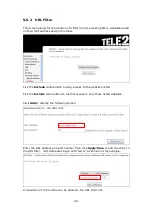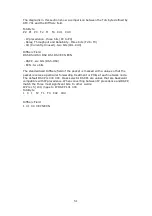
51
The diagrams in this section show a comparison between the ToS byte defined by
RFC 791 and the DiffServ field.
ToS Byte
P2 P1 P0 T2 T1 T0 CU1 CU0
‧
IP precedence
—
three bits (P2 to P0)
‧
Delay, Throughput and Reliability
—
three bits (T2 to T0)
‧
CU (Currently Unused)
—
two bits(CU1-CU0)
DiffServ Field
DS5 DS4 DS3 DS2 DS1 DS0 ECN ECN
‧
DSCP
—
six bits (DS5-DS0)
‧
ECN
—
two bits
The standardized DiffServ field of the packet is marked with a value so that the
packet receives a particular forwarding treatment or PHB, at each network node.
The default DSCP is 000 000. Class selector DSCPs are values that are backward
compatible with IP precedence. When converting between IP precedence and DSCP,
match the three most significant bits. In other words:
IP Prec 5 (101) maps to IP DSCP 101 000
ToS Byte
1 0 1 T2 T1 T0 CU2 CU0
DiffServ Field
1 0 1 0 0 0 ECN ECN
Summary of Contents for VI-3223u
Page 1: ...VI 3223u Multi DSL WLAN IAD User Manual Version B1 0 July 19 2013 261099 020...
Page 7: ...6 1 2 Application The following diagram depicts a typical application of the VI 3223u...
Page 16: ...15 STEP 3 After successfully logging in for the first time you will reach this screen...
Page 26: ...25...
Page 32: ...31 Chapter 5 Advanced Setup The following screen shows the advanced menu options...
Page 67: ...66 5 11 UPnP Select the checkbox provided and click Apply Save to enable UPnP protocol...
Page 72: ...71 5 15 1 Storage Device Info Display after storage device attached for your reference...
Page 74: ...73 Automatically Add Clients With Following DHCP Vendor IDs...
Page 98: ...97 Click Apply Save to set new advanced wireless options...
Page 103: ...102 7 1 SIP Basic Setting 7 1 1 Global Parameters A common parameter setting...
Page 104: ...103 7 1 2 Service Provider This screen contains basic SIP configuration settings...
Page 106: ...105 7 2 SIP Advanced This screen contains the advanced SIP configuration settings...
Page 107: ...106 7 2 1 Global Parameters A common parameter setting...
Page 172: ...171 Click Next to continue or click Back to return to the previous step...
















































